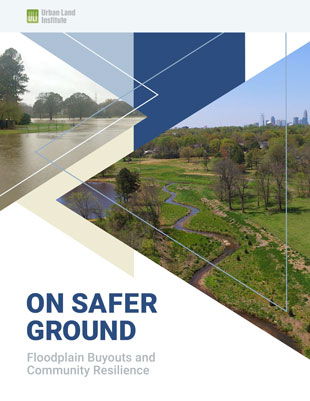Local governments increasingly turning to floodplain buyouts to reduce flood risk but not always being leveraged to provide much-needed community benefits.
A new ULI report explores how floodplain buyouts can be a cost-effective land use tool to mitigate damage from rising water levels and get people out of harm’s way, but they require long-term strategies to offer community benefits.
 Flooding is the most expensive and common natural disaster in the United States, and managing flood risk is critical to protecting homes, local and regional economies, and community well-being. On Safer Ground: Floodplain Buyouts and Community Resilience highlights that within the next 30 years, $8 billion to $10 billion of California’s existing coastal property is predicted to be underwater and an additional $6 billion to $10 billion will be at risk to flooding during high tide.
Flooding is the most expensive and common natural disaster in the United States, and managing flood risk is critical to protecting homes, local and regional economies, and community well-being. On Safer Ground: Floodplain Buyouts and Community Resilience highlights that within the next 30 years, $8 billion to $10 billion of California’s existing coastal property is predicted to be underwater and an additional $6 billion to $10 billion will be at risk to flooding during high tide.
Faced with this potential crisis, local governments across the United States are increasingly turning to buyouts as one strategy to cost-effectively reduce flood risk, offer relief to residents, and potentially improve access to open space in urban areas. The report explores how changing rainfall patterns, stronger storms, and sea-level rise are increasing the flood risk and costly damage to property and infrastructure.
A floodplain buyout is a property acquisition in which a government agency purchases private property, demolishes any structures on it, and preserves the land as open space, as an area that absorbs excess water, or for both purposes. Although buyouts are currently almost entirely used for residential properties in the United States, the increased use of the approach in urban areas has important implications for all real estate types and for future land use regulation and climate resilience strategy.
“Floodplain buyouts are just one of several tools that governments can use as part of a climate resilience strategy, and their increasing use by governments may be a signal for the private real estate sector to prepare for more involvement in the practice,” says Leah Sheppard, manager of the ULI Urban Resilience program and lead report author. “As more land use decision-makers avail themselves of this approach, innovation in policy and partnership models may help break barriers for buyouts.”
The report looks at the best practices and models for implementing floodplain buyouts, including the following:
- Engaging with communities equitably: To create a voluntary buyout program and visions toward implementation of future plot uses, it is best to clearly communicate and engage with residents. This includes prioritizing at-risk communities equitably, maintaining transparent communication and outreach, ensuring that all aspects of the buyout program remain voluntary, bringing in independent third parties throughout the process to enhance community trust and provide objective analysis, and offering full cycle support.
- Seeking perennial and sustainable funding streams to work with homeowners on sensible, compassionate buyout plans: Emerging partnership models and funding mechanisms can potentially offer strategies to create funding availability and advance buyout projects before a disaster strikes.
- Leveraging the buyouts for enhanced open space: Bought-out properties, considered either as individual parcels or at larger, multiparcel scales, can offer a range of benefits to both the ecosystem and community residents, with an eye toward flood resilience, including offering aesthetic value, restoring ecological function, creating natural flood buffer zones, and offering recreation and educational opportunities.
On Safer Ground also provides examples of communities that have successfully implemented floodplain buyouts and leveraged purchased sites for open space or other community amenities:
- In 1995, New Jersey created a state program called “Blue Acres.” After Superstorm Sandy ravaged the state and destroyed hundreds of coastal homes, the Blue Acres staff ramped up its work to counsel, advocate for, inform, and listen to homeowners who may be considering a buyout. This buyout program provides support for relocation assistance to property owners and tenants in flood-prone areas.
- Because of extreme demand to protect its sewers and pipes, Mecklenburg County, home of Charlotte, North Carolina, created a stormwater utility. The fees created by this utility have created a constant revenue stream for its Floodplain Buyout program, which has acquired more than 400 properties and returned over 180 acres (73 ha) to floodplains to natural land and open space. This has saved taxpayers over $25 million in property damages since 1999. Along with this, having stable, annual revenue streams has enabled the city to plan buyouts that make new, coordinated public places more feasible.
- Harris County, Texas, home of Houston, has faced the issue of catastrophic floods for decades. In response, the Harris County Flood Control District mounted the Voluntary Acquisition Program to identify property in likely inundation paths and work with residents. It finds success on two paths: delivering public spaces that control flooding impact and executing buyouts that rescue homeowners. The Community Flood Resilience Task Force advises county officials on how to equitably distribute a $2.5 billion bond for flood mitigation projects and buyouts for homes affected by Hurricane Harvey.
- The Church Creek drainage basin, in Charleston, South Carolina, has repeatedly flooded, affecting nearly 50 townhouses. In 2015, after a 1,000-year flood event, the city of Charleston bought out residents and embarked on the Church Creek basin resilience project, which will mitigate flooding for the surrounding community by delivering a 20-acre (8 ha) greenway and park system that will offer water storage during weather events and a new amenity.

Nashville’s Riverfront Park. (Flickr/Tyler Neu)
Riverfront Park in Nashville offers another of example of the transformation of buyout properties into a park offering flood mitigation and recreational amenities. The park is located on previously industrial land next to the Cumberland River that was bought out following a devastating 1,000-year flood event in 2010 and is designed to mitigate flooding and provide a dynamic public gathering space.
Kim Hawkins is founding principal of Hawkins Partners, a landscape architecture and planning firm based in downtown Nashville, and the chair of ULI Nashville. Hawkins was the lead landscape architect on the Riverfront Park project: “The downtown riverfront park utilizes multiple low-impact development strategies on a brownfield site, including bioretention, pervious pavements, green roof, urban tree cover, and a 375,000-gallon rainwater harvesting cistern buried under a wing of the amphitheater for park irrigation.”
“Floodplain buyouts are a key tool for real estate and land use decision-makers to understand,” says Katharine Burgess, vice president of urban resilience at the Urban Land Institute and contributing author of the report. “Notably, buyouts offer one key example of household-level migration away from sites which are experiencing repetitive flooding losses and offer a glimpse into potential future migration trends due to the impacts of climate change.”
On Safer Ground: Floodplain Buyouts and Community Resilience is available on ULI’s Knowledge Finder platform.



